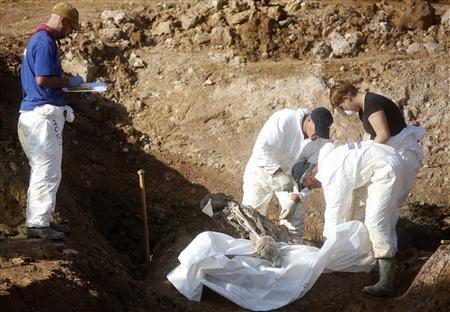Listeners:
Top listeners:
-
play_arrow
Radio Naša Riječ Chicago

< !DOCTYPE html PUBLIC "-//W3C//DTD XHTML 1.0 Transitional//EN" "http://www.w3.org/TR/xhtml1/DTD/xhtml1-transitional.dtd">
By Daria Sito-Sucic
TOMASICA, Bosnia
Forensics experts are excavating what may be the largest mass grave of ethnic cleansing victims in Bosnia, a site whose existence was known for years but exact location covered up by a Serb wall of silence, the state's missing persons office said.
The U.N. war crimes tribunal in The Hague has sentenced 16 Bosnian Serbs to a total of 230 years in prison for atrocities in the Prijedor area of northwest Bosnia where the Tomasica site is situated but not all mass graves have been found in the area.
Bosnia's Institute for Missing Persons had known for years about the Tomasica tomb but the exact venue and details of the victims were known only to local Serb witnesses who had remained mum since the end of the 1992-95 war.
“We conducted the investigation for two years and finally found people who were willing to talk,” said Mujo Begic, the forensic team supervisor. Some witnesses were former separatist Bosnian Serb fighters who could no longer keep the secret.
At Tomasica, the white-garbed forensic experts are recovering bodies of Bosnian Muslims, or Bosniaks, and Croats killed by separatist Serbs in one of the worst ethnic cleansing campaigns aimed at driving out non-Serbs in the country's war.
On Tuesday, the remains of 18 people were unearthed from the grave, which spreads across 3,000 square metres in uninhabited green hills. All the victims, men, women and children, were shot dead, forensics workers said. Many were wrapped in blankets.
Begic said his team expected to find the remains of 17 children, the youngest an 18-month-old baby, from the Bacic family killed along with their mother, grandfather and uncle.
As bulldozers removed layer after layer of thick clay, the sickening, all-pervading stench of decomposing bodies rose.
POSSIBLY LARGEST MASS GRAVE
 The first bodies at Tomasica were found at the depth of seven metres (23 feet) in August and the remains of 240 people have been exhumed to date – believed to be Muslim villagers from the Prijedor area.
The first bodies at Tomasica were found at the depth of seven metres (23 feet) in August and the remains of 240 people have been exhumed to date – believed to be Muslim villagers from the Prijedor area.
Witness accounts have established that around 1,000 people were buried there originally but there are indications that some were subsequently dug up and reburied elsewhere to cover up traces of the crime.
Lejla Cengic, spokeswoman for the Missing Persons Institute, said Tomasica could prove the largest single mass grave in the ex-Yugoslav republic. The largest excavated so far, Crni Vrh in eastern Bosnia, contained 629 bodies.
Bosnia's war, touched off by its secession from Serbian-dominated federal Yugoslavia, killed around 100,000 people and gave rise to the worst atrocities in Europe since the Holocaust.
The 1995 Dayton peace deal divided Bosnia into an autonomous Serb Republic, where Prijedor is located, and a Muslim-Croat federation. Ethnically motivated feuding continues to stall Bosnia's bid to join the European mainstream.
Tomasica is one of almost 100 mass graves tracked down in northwest Bosnia since the war.
The Prijedor region was a stronghold of ultra-nationalist Serbs during the war who sought to oust all Bosnian Muslim and Croat inhabitants to create exclusive Serb territory in Bosnia. Nearly 3,500 people went missing from Prijedor town alone.
Suad Zeric, a Bosnian Muslim from a nearby town who was held in a Serb detention camp during the war, was able to identify one of four missing uncles among the remains at Tomasica.
“I truly hope my three other uncles will also be found,” said Zeric, who now lives with his family in France.
While not interfering with mass grave digs by the Sarajevo-based Missing Persons office, the Serb-led Prijedor regional authorities ban any local commemorations for war crimes victims.
(Reporting by Daria Sito-Sucic; Writing by Zoran Radosavljevic; Editing by Mark Heinrich)
Written by: hazmirmanija
